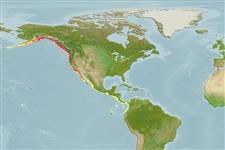>
Perciformes/Zoarcoidei (Eelpouts and pricklebacks) >
Zoarcidae (Eelpouts) > Lycodinae
Etymology: Lycodes: Greek, lykos = wolf + Greek, suffix, oides = similar to (Ref. 45335); pacificus: Named after the Pacific Ocean (Ref. 6885).
Environment: milieu / climate zone / depth range / distribution range
Ecologie
marien bathydemersaal; diepte 9 - 399 m (Ref. 2850). Deep-water
Eastern Pacific: Gulf of Alaska to northern Baja California, Mexico.
Lengte bij maturiteit / Grootte / Gewicht / Leeftijd
Maturity: Lm ?, range 14 - ? cm
Max length : 46.0 cm TL mannelijk / geslacht onbekend; (Ref. 2850); max. gerapporteerde leeftijd: 5 Jaren (Ref. 6885)
Korte beschrijving
Morfologie | Morfometrie
Dorsale stekels (totaal): 0; Dorsale zachte stralen (totaal): 90-107; Anale stekels 0; Anale zachte stralen: 70 - 90. Caudal sharply rounded but not readily distinguishable from dorsal and anal fins. Pelvic fins minute.
Found on silty or sandy bottoms (Ref. 27436). Moves into shallow water at night to feed on marine worms, crustaceans, small bivalves, and brittle stars (Ref. 6885, 27436). Few live over 5 years (Ref. 6885). If used live as bait, it attracts large rockfishes, greenlings or codfishes (Ref. 27436). Flesh considered good but not esteemed (Ref. 27436).
Levenscyclus en paargedrag
Maturiteit | Voortplanting | Paaien | Eieren | Fecunditeit | Larven
Anderson, M.E., 1994. Systematics and osteology of the Zoarcidae (Teleostei: Perciformes). Ichthyol. Bull. J.L.B. Smith Inst. Ichthyol. 60:120 p. (Ref. 11954)
Status op de Rode Lijst van het IUCN (Ref. 130435)
Gevaar voor de mens
Harmless
Gebruik door de mens
Visserij: visserij voor eigen gebruik
Meer informatie
ReferentiesAquacultuurAquacultuurprofielKweeklijnenGeneticaElectrophoresesErfelijkheidZiektesVerwerkingNutrientsMassaconversie
Tools
Speciale rapporten
Download XML
Internetbronnen
Estimates based on models
Preferred temperature (Ref.
123201): 5.3 - 9.4, mean 6.8 °C (based on 123 cells).
Fylogenetische diversiteitsindex (Ref.
82804): PD
50 = 0.5000 [Uniqueness, from 0.5 = low to 2.0 = high].
Bayesian length-weight: a=0.00263 (0.00137 - 0.00504), b=3.22 (3.06 - 3.38), in cm total length, based on LWR estimates for this Genus-body shape (Ref.
93245).
Trofisch niveau (Ref.
69278): 3.3 ±0.43 se; based on food items.
Generation time: 3.5 ( na - na) years. Estimated as median ln(3)/K based on 1
growth studies.
Weerstandsvermogen (Ref.
120179): laag, minimale populatieverdubbelingstijd 4,5-14 jaar (Ave. Fec=30).
Fishing Vulnerability (Ref.
59153): Moderate to high vulnerability (47 of 100).
